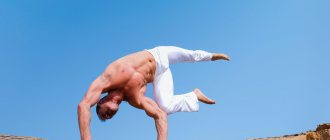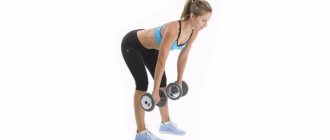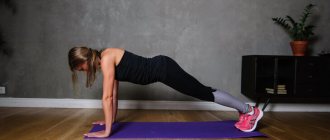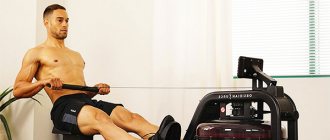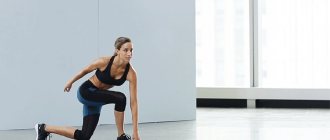Advantages, disadvantages, contraindications
Let's evaluate the benefits and harms of “home” running. First, let's look at the positive aspects of such activities:
- no sports equipment required;
- you can practice in any weather;
- saving time;
- moderate load on the knees and spine;
- lack of embarrassment in front of others;
- free class schedule.
Disadvantages of home jogging:
- low efficiency (compared to classic running on the street);
- monotony;
- lack of fresh air.
Running on the spot at home does not harm the body, but is simply less productive than street exercise. In defense of home training, we note that it has many useful properties:
- cardiovascular training;
- strengthening muscles, ligaments, tendons;
- improved digestion;
- normalization of the reproductive system;
- weight loss;
- calming the nervous system;
- getting rid of depression;
- working on women's problem areas (hips, buttocks, back of the arms).
Despite the “mild” effect on the body, running at home has some medical contraindications:
- damage to the spine or joints;
- varicose veins;
- coronary syndrome;
- late stages of pregnancy;
- recovery period after surgery.
If you have health problems, be sure to visit your doctor. Only he can decide on the use of physical activity as a preventive measure. Otherwise, you risk worsening your health and accelerating the progression of the disease.
According to statistics, Russia is in third place in the prevalence of hypertension. The disease is characterized by high blood pressure, which damages the cardiovascular system and other internal organs. As a result, the risk of developing irreversible consequences increases.
Moderate sports activity is considered one of the methods for preventing hypertension. Running in place is suitable as physical therapy. It helps to dilate blood vessels, relax muscles and normalize blood pressure.
What muscles are involved?
Like classic outdoor jogging, jogging in place forces the whole body to work. The load is placed on the legs, abs, back, and shoulders.
Due to the specific technique, the emphasis falls on the lower legs (calf, soleus) and thighs (quadriceps). Thanks to this, the athlete gets the opportunity to make his legs slimmer.
Of course, we are not talking about any gain in muscle mass. Running exercises in place help correct the shape of the lower extremities, toning the muscles and reducing body fat.
Summary
Jogging in place is a great alternative for those who don't want or can't leave the house for a regular run. It allows you to stay in shape, additionally load your heart and muscles, and even lose a little weight.
It is important to follow the exercise technique so as not to harm yourself, and in the future, to hone your running movements. Running in place for 30-40 minutes 2-3 times a week will bring results, observing your heart rate zones. Do not forget to warm up and cool down and do not start training if there are contraindications.
Elena Matveeva
Warm up before running in place
It is necessary to warm up muscles, ligaments, tendons, and joints before each workout. First, it reduces the risk of injury. Secondly, it improves the body's sensitivity to stress. We offer an example of a simple warm-up for home training:
- Squats without additional weight (15–20).
- Forward lunges (15 on each leg).
- Rotations in the knee and ankle joints (20 times each).
- Swing your arms (20 times forward and backward).
- Bend forward and to the sides (15–20).
- Jumping in place with high hips (10–12).
If you have a cardio machine at home (elliptical, stepper), replace the leg warm-up with 10 minutes of walking at a calm pace. This will be enough to warm up your whole body and prepare for the main part of the lesson.
How to combat excess heat with running exercises
With short cardio workouts, you can achieve good results in terms of removing excess water (drying), strengthening the heart muscle and musculoskeletal system, but losing weight in 5-10 minutes a day is virtually impossible. This is explained by the fact that during training, the muscles only warm up during the first time, and only after 10-15 minutes they begin to actively break down carbohydrates. But the task of losing weight is the breakdown of fat, which occurs only after 25-30 minutes.
On average, when calculating for a person aged 20-45 years, we can answer the question of how many calories can be burned when running - 12-13 kilocalories per minute. This figure is suitable for the stronger sex; for women it is 15% less due to the structure of the body. The female body as a whole is more adapted to storing fat for pregnancy, so it “gives off” heat much more reluctantly.
How does distance affect
The average speed to cover one kilometer is 6-7 minutes, at a high pace - 5. Such a short kilometer warm-up will “cost” you 200-250 kcal, which you will gain back at the first snack. The longer the route, the greater the effect. But remember three rules:
- start with short sessions, gradually increasing them;
- every cardio workout starts with stretching;
- If you have a large body weight, first take long walks, gradually speeding up.
A good distance for beginners is 2-3 km, for intermediate ones – from 5 to 10 km. You need to focus, first of all, on your own well-being.
How many calories are burned during different types of running?
For weight loss, the best option is jogging or brisk walking, this allows you to maintain a continuous load for a long time. Sprinting, that is, maintaining a speed interval of 15 to 20 km/h, is not compatible with long training, so acceleration can only be used occasionally. If you cannot maintain constant tension, you can alternate it with walking, but do not stop completely. So a scheme of 10 minutes of jogging and the next 10 minutes of walking with alternations for an hour will also help to effectively get rid of 300 - 350 kcal.
Moving on flat terrain
A straight surface is most comfortable for leisurely running. Specially equipped stadiums, walking paths in the park or a treadmill in the gym or at home are suitable. The advantage of this type:
- the choice of speed limit depends on you, not on the terrain;
- you don’t have to worry about coordinating movements, they are all uniform and identical;
- the step amplitude is constant;
- It’s easy to calculate the load on the body and the result depending on the duration and speed.
How many calories are lost when running up stairs or uphill?
In this case, the angle of inclination (on a treadmill this indicator is set manually), the choice of terrain, as well as the width and height of the steps are important.
Please note that stair trainers are installed only in one direction - uphill. This is due not only to the fact that the kcal consumption is higher, but also to the fact that during the descent you can damage your joints and get a sprain. For this reason, we do not recommend running up and down regular stairs in your home.
More energy is consumed, since movements need to be made more sweepingly (lifting the leg), and the muscles are under greater stress. For a man with average training and weighing about 70 kg, consumption for 10 minutes is 170 kcal, and for an hour - all 1070.
Technique of running in place
Correct technique is the key to the effectiveness of any exercise. The same applies to running elements. To make home training productive, adhere to the following rules:
- Start by simply walking in place. There is no need to raise your knees high. The task of this stage is to smoothly enter the training regime. Continue for 2 minutes.
- Then move on to easy running in place. Keep your back straight. Try not to lower your heels to the floor, move on your toes. As you raise your hip, also lift your opposite arm, bent at the elbow.
- Relax your shoulders, don't lean forward, don't lower your head. If it works, breathe through your nose; if not, use a mixed style (inhale through your nose, exhale through your mouth).
- Some beginners make the grave mistake of sticking their toe into the floor. This harms the ankle and knee joints. Therefore, when moving, try to lower your foot gently.
- Once you have completed the main part of your workout, gradually reduce your pace until you reach a walk. “Walk” in place for a couple more minutes to calm your heart and restore your pulse.
In home training, it is not at all necessary to use equipment and, in particular, sports shoes. You can exercise barefoot or in socks. But be prepared for the fact that after class there will be pain in the toes of your feet. If this happens constantly, we recommend running in sneakers. Professional models with shock-absorbing soles are best suited.
Breathing while running
When asked whether running in place is beneficial or harmful, it is important to consider the load and technique, because they greatly affect the runner’s breathing.
Breathing technique when running: rhythmic breathing, inhale through the nose, exhale through the mouth. The exhalation should be 2 times longer than the inhalation. However, during training on the spot, you do not bother with the pace, beat, running speed and do not try to adjust your breathing to these parameters. Therefore, when jogging in place, it is easier to breathe steadily. To maintain the heart rate zone limits, parameters must be measured regularly during training.
When practicing in a room, it is important to regularly ventilate the room to saturate the body with oxygen. If necessary, you can move the training to a loggia or balcony.
How to reduce running noise
Neighbors sensitive to any noise can interrupt your running workout. To prevent this from happening, follow these recommendations:
- wear shoes with soft soles;
- Land exclusively on your toes, leaving your heels elevated;
- use a special non-slip fitness mat;
- work out during the day.
Don't forget, making noise in the evening is prohibited. Each region has its own legislative rules for maintaining silence. For example, in Moscow it is prohibited on weekdays to interfere with the rest of neighbors from 23:00 to 07:00, and in St. Petersburg - from 22:00 to 08:00.
How to choose the right time for training
On weekdays, when you visit the gym, 20 minutes or half an hour will be enough to jog on the mat at home. The complex can be performed during the moments reserved for morning exercises. On other days, without strength training, it is recommended to run in the same place at intervals (run alternating paces and styles).
The number of calories burned with this approach is directly proportional to the correct execution of this set of exercises:
- The training usually begins with simple movements in the form of walking, which, in essence, is a warm-up.
- The next stage is alternation. It consists of alternately changing the pace of movements. First - a minute of movements at a calm pace, then - two minutes of fast running, at the end - a minute of recovery running exercises, etc.
- If desired, the latter, restorative exercises, can be replaced by exercises with a hula hoop or a health disc.
Important: Running in the same place burns calories. To experience real benefits, it is important to spend at least 180 minutes a week running in the same place.
How to diversify running in place
Music is a runner's faithful companion. To make your workout more enjoyable, play your favorite tracks. It is advisable that the songs match the rhythm of the lesson. This will make physical activity much easier to bear.
If music doesn't stimulate you to move, you can turn on the TV. Please note that it is not advisable to view intellectual programs during class. The brain will try to simultaneously grasp the meaning of the information and maintain the pace, which can negatively affect the training.
If you want to add some variety to your monotonous running, periodically speed up for 10–15 seconds. This way you will improve the development of the muscles of the lower body. You can add jumps - pushing off with one leg while simultaneously lifting the opposite knee.
For experienced athletes, we recommend making exercise more difficult with weights. Take light dumbbells or put sand weights on your wrists and shins. Additional exercise will help increase calorie consumption and lose weight.
Running in place and burning fat
Any intense exercise speeds up metabolic processes and burns calories. Therefore, running in place is effective for losing weight.
The rapid reduction in body fat when running is associated with the expenditure of calories. Jogging on the spot allows you to burn about 250–300 kcal per hour of continuous training. For comparison, classic jogging helps you burn an average of 500 kcal per hour. But those who study at home should not be upset. To increase energy expenditure, use soft weights or add special exercises to your workout (more on them later).
A few words need to be said about the duration of running sessions. For beginner athletes, we recommend training no more than 15–20 minutes in the first month. This is necessary for the muscles to gradually adapt to the load. After week 4, gradually increase the training time to 30 minutes.
Experienced athletes should run for at least 40 minutes. This is due to the fact that first the body burns glycogen reserves (the main source of energy for muscles) and only then begins to consume subcutaneous fat. Glycogen lasts for half an hour. Therefore, weight loss training should last 40–45 minutes.
The number of classes is determined individually. Start with three workouts per week. If you don't feel tired on rest days, add another workout. The main thing is not to overdo it. Otherwise, you can reach a state of overtraining, which will negatively affect the results of your runs.
Weight loss processes start only with a calorie deficit. Actually, running in place is needed to create a negative energy balance (when an athlete spends more energy than he receives from food). But physical activity alone is not enough. It is necessary to review the diet and avoid foods with a high glycemic index (baked goods, sugar, confectionery). The combination of a low-calorie diet and regular running exercises will quickly get rid of extra pounds.
Running in the same place at home for weight loss: exercise and movement techniques
Exercise technique
Does running in the same place help you lose weight? Of course, if you take into account a few important rules:
- To obtain a minimal effect, 10-15 minutes of daily training is enough to make the process go faster; you can supplement the complex with general exercises for different muscle groups;
- Gradually increase the power of the loads and extend the time spent on training;
- Interval running exercises with high leg raises can also speed up results.
Important: To avoid sprains, be sure to do a full warm-up before intense running.
Running exercises
Let's consider exercise options that can be used to increase the load and fully work out the muscles of the lower extremities:
- Running with overwhelm . The athlete tries to touch the heel to the buttocks with each lift of the foot. The exercise stretches the quadriceps well and effectively loads the hamstrings.
- Running with high knees . When performing, the hips rise to parallel with the floor or higher. Exercise helps increase the number of calories burned and increases the stress on your hips.
- With arms waving . The athlete performs a simple run in place and simultaneously rotates his arms forward. The element additionally strengthens deltoids and accelerates weight loss.
- Running in place while lying down . Exercise helps diversify your workout. In addition, when performing, not only the muscles of the legs are worked out, but also the arms and abs.
- Running onto the platform . The exercise uses a step platform. The athlete moves energetically, moving his feet from the floor to the stand and back. The element accelerates the burning of calories.
- Lateral movements with jogging . The athlete takes quick short steps in place, sharply shifts to the side a meter and again takes 3-4 running steps. Then he repeats it back. The exercise allows you to develop agility, mobility, and speed.
Running in place and jumping
In addition to the elements discussed above, we recommend adding plyometric loads to your running training. For example, jumping rope can replace a warm-up or increase calorie expenditure by doing two 10-minute approaches before and after running. By the way, when using a jump rope, an athlete spends the same amount of calories as during classic jogging (about 500 kcal/hour).
Jumping elements can also be included in the lesson itself. We have already said that jumping helps to diversify the monotonous rhythm of training. In addition, using plyometric exercises, the athlete improves the development of the lower body. For example, jumping out of a lunge with a split leg loads not only the large muscles of the legs, but also the small muscles responsible for stabilization.
Which is better: running in place or treadmill?
A treadmill is definitely better, as it has many advantages:
- When moving on the simulator, the athlete takes full running steps, which increases the beneficial effect on the body.
- The track has the option of changing the load, which is necessary for gradual progression.
- The cardio machine is equipped with additional functions that allow you to monitor the results and condition of the athlete: measuring the distance traveled, calories burned, pulse, etc.
- A variety of exercises are performed on the electronic track that work the leg muscles well.
- Variable load and the ability to run fully contribute to the rapid loss of excess weight.
Yes, the electronic track is an expensive projectile. If purchasing such a machine is not practical, then running in place will help reduce body fat and improve the appearance of your legs. Although this will take more time.




